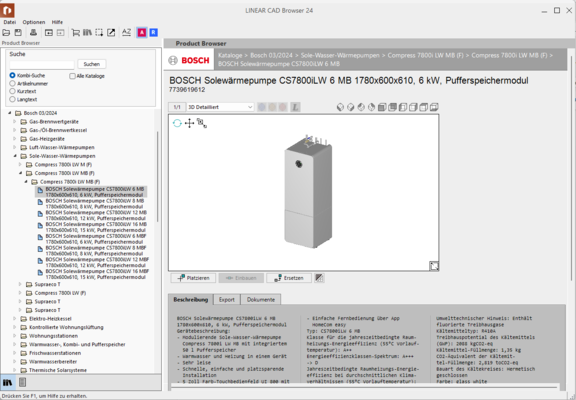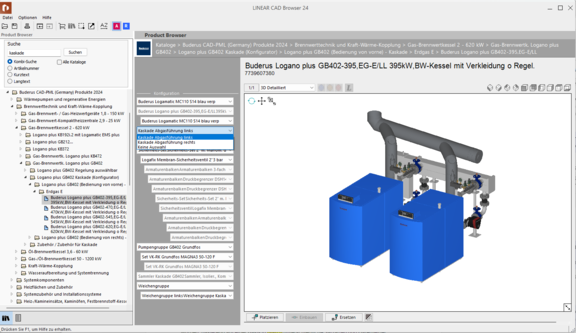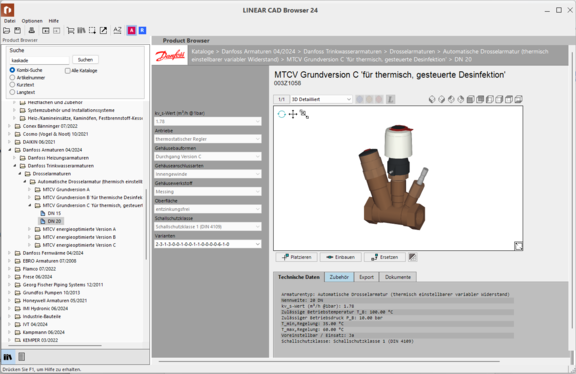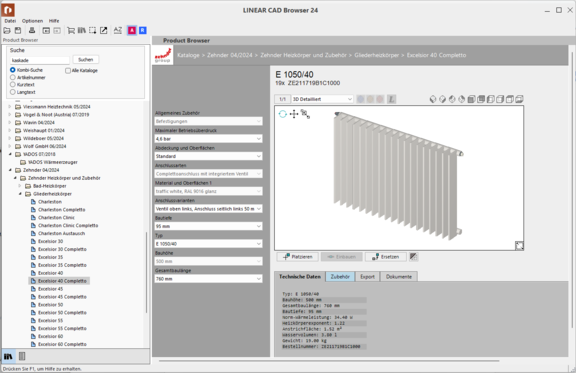
When LINEAR created the first manufacturer catalogs in the form of CAD component libraries in the early 1990s, these were the first on the market and there were no standards for this type of product data.
Therefore, a flexible format was developed which allowed users to manage existing CAD geometries (DWG and DXF files) in a structured manner in form of catalog groups and a convenient user interface. Already back then, this included a preview of the product as well as short and long texts for material extracts in combination with the prevailing format for commercial data (DATANORM).
This format is still ideal for product portfolios in which the individual products are already available as drawings or models.
The manufacturer’s catalog structure can be replicated here, which is exactly the intention. After all, the LINEAR CAD Browser should be able to replace the printed product catalog, at least for CAD applications. For this reason, this analogy is very helpful in finding the products.
With a powerful configuration engine, products can be combined and, in this process, undergo a plausibility and dependency check. The preview allows for a direct check of the result.
The VDI 3805 format, which was developed later, originally focused on the provision of technical design data. Based on annex 1 of this VDI standard, different set types and data fields were defined for the different product categories. At that time, the first available data sets were based on annex 2 for radiator valves and annex 6 for radiators.
This has the following advantages
There is no need to create and provide thousands of models.
The model can be generated for different target platforms. Once created, the manufacturers do not have to supply any further data formats for other software solutions for building services. The software must only be able to process VDI 3805 data.
Parameters and a built-in programming language are used to solve the problem that quickly becomes apparent, especially looking at radiators: The combination of length, depth and height with different connection positions quickly leads to tens of thousands of different radiators. And of course, it makes no sense to create or describe all of them individually.
Now the creation of geometries according to VDI 3805 is anything but trivial. This is one of the reasons why not all VDI 3805 files contain design data. LINEAR has therefore developed its own graphics editor as an application for AutoCAD, so that either DWGs or VDI 3805 design data can be generated without changing the software environment.
The only fly in the ointment, if you will, is the predefined structure in the VDI 3805 file, which in many cases does not match the catalog structure. However, the built-in search function in the LINEAR CAD Browser can compensate for this quite well.
Which formats for which products?
Our experience has shown that different formats make perfect sense for the highly variable products in the building services sector.
Individual CAD models with technical and commercial data can be an economical way to offer product data for individual appliances or manageable product portfolios with little repetition. Especially if CAD models are already available for these purposes.
However, configurable component groups such as flexible cascades with predefined pipe connections, large boilers or hydraulic modules can also easily be created this way. They help with the definition of dependencies, plausibility checks and safe product selection.
The VDI 3805 format shows its advantages with components with several dimensions and alternative accessories. This not only allows you to restrict the selection of product options. The technical data that may depend on this is also always correct.
VDI 3805 also stands out regarding other similar components, such as radiators or ventilation components - provided that the design data for generating the geometry is also included.
This explains why the LINEAR Data detection in VDI 3805 format is more complex overall, but the advantage of universal applicability in any building services software is now convincing more and more manufacturers.
However, it is important to know that VDI 3805 sheets are not defined for all types of products. We always advise our industry partners with great attention to detail and can recommend the right approach to suit the product portfolio.
Conclusion
Prefabricated CAD models have become an integral part of daily planning work. Regardless of the data source, working with LINEAR CAD Browser or LINEAR Content Hub remains consistent and logical. Depending on the selection and combination of product options, the preview is updated, and the model appears in the target platform attached to the cursor to be placed. Precise and with all connections and technical data. Simple and timesaving.



